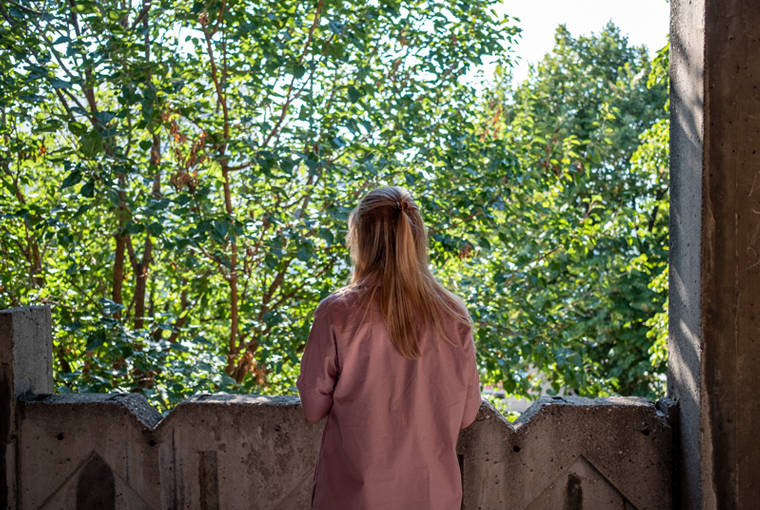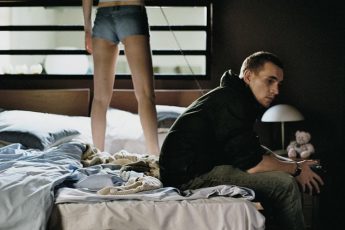(Im)possible Fantasies of Reconciliation and Forgiveness in Contemporary Bosnia and Herzegovina
Teona Strugar Mitevska’s The Happiest Man in the World (Najsreќniot Čovek na Svetot, 2022)
Vol. 135 (May 2023) by Ana Grgić and Antonis Lagarias
Almost three decades after the disintegration of Yugoslavia and a series of vicious wars, memory and trauma continue to haunt cinematic images from the region. Yugoslavia, a multi-national, multi-ethnic, and multi-religious confederation, had championed non-aligned politics and looked both East and West. Its multi-national society shared the Second World War partisan liberation narrative and the brotherhood and unity motto under the stern guidance of its longtime president Tito. The newly independent countries gathered around nationalistic values and ideals of mono-ethnicity and mono-religion, cleansing the unwanted others through acts of violence, oppression, and/or stigmatization. The Bosnian war in particular was marked by ethnic cleansing and massacres, with Srebrenica being the most known case, but also by the four-year siege of Sarajevo, one of the longest sieges in modern history. Divided by their ethnicity, the city’s inhabitants had to choose sides while enduring an incessant barrage of shells and sniper fire from the Serbian troops encircling the city. In Europe alone, there were around 250 feature films made about the Bosnian war, whereas the conflicts across former Yugoslav countries were some of the most mediatized news images in the 1990s, shaping public opinion about the war and its consequences.1 The cinematic representations of the Bosnian war and its aftermath include action films which foreground tropes of masculinist melodrama and reinforce stereotypical representations of ethnicity, dramas which explore the experience of foreign “humanitarian” personnel during the war, films directed by women which dealt with the subjective experience of wartime rape victims, and diverse films that explore differing narratives of the war. Today, less than 30 years after the war, Sarajevo remains a multi-ethnic city, even if the largest group identify as Bosniaks (77.4%) and its Eastern suburbs are now part of Republika Srpska, where mostly Serbs reside. In that sense, Sarajevo is a prime example of a divided city with a fragmented urban landscape and a population that is still marked by the horrors and suffering of war.
War trauma and memory, wounds and healing are the driving force behind the narrative in Teona Strugar Mitevska’s latest feature The Happiest Man in the World. The North Macedonian director, known for films featuring strong female characters who struggle within and at times challenge their patriarchal societies, collaborated with Bosnian screenwriter Elma Tataragić to deliver an emotion-packed story inspired by true events.2 This Macedonian-Bosnian-Belgian-Croatian-Danish-Slovenian co-production revisits the societal consequences of the lasting trauma of the conflicts through the prism of loneliness and the desire for connecting with others. The story – which is related in Bosnian – features a colorful group of people, war victims and veterans as well as people born after the war, who all take part in a speed-dating event held in a drab socialist-era hotel. In search of a potential love partner, Asja (Jelena Kordić Kuret), a woman in her forties, is matched with Zoran (Adnan Omerović), a handsome yet sullen man who shutters and trembles, clearly shaken by her presence. During their discussion, it becomes clear that both Asja and Zoran are hiding something, causing tensions between them to rise. As the uncertainty grows, Zoran reveals that he only attended the event to meet Asja, and asks her if she had been wounded in the war. The film then turns into a confrontational drama in three acts as it is revealed that Asja’s home was shelled by sniper fire during the war, when she was just a child, by a military group which Zoran was forced to join as a young boy. Having focused his fire on a child’s blanket, Zoran is certain that it was he who shot and wounded her. The second act follows Asja’s growing anger and despair as she is forced to confront her shooter. The rest of the group is caught up in their confrontation and, thus, all sorts of personal and collective traumas resurface. Finally, in the third act, Asja forgives and embraces Zoran in an act of reconciliation.
The opening sequence introduces the two protagonists, Asja and Zoran, through a series of fragmented close-ups and handheld shots that collectively reveal only the back of their heads and isolated details of their bodies. We follow Asja through the streets of Sarajevo to the brutalist-style hotel, a remnant of Socialist architecture evoking Yugoslav times. The city of Sarajevo is presented as an urban space marked by contradictions and ambivalence: from a construction site where bulldozers are digging up the ground and concrete is being poured for new buildings to replace the spatial and material traces of the former site of the four-year siege of Sarajevo, to images of buildings which conserve decade-old bullet holes still serving as material reminders of the wounds inflicted on the city and its population. The hotel conference rooms where the social games and the drama unfold bear the names of Swiss cities, such as Zurich or Basel, ironically, as the symbol of neutral space becomes the present site of past conflicts. Indeed, the participants engage in childhood games, such as “between two fires”, which anyone growing up in former Yugoslavia would recall with both nostalgia and horror, since, here, the act of hitting a target with a ball echoes the sniper shootings during the siege. This juxtaposition between harmless games and acts of violence seems to suggest a much deeper and complex connection between innocence, childhood naivety and serious crimes. To some extent, the film attempts to raise questions around the notions of “victim” and “perpetrator” through the confrontation and the building up of sexual tension between Asja and Zoran, but somehow fails to truly offer a more nuanced reading of this confrontation and its resolution. Privy to intimate encounters, the film has Asja and Zoran converge both psychologically and physically, once on the terrace, where she first confronts him about his memory and knowledge of the past, and later in the bathroom as Zoran traces Asja’s scars with his fingers, and both hold each other in an embrace of mutual understanding. The struggle for reconciliation and healing is presented as a multifarious process, strewn with frustration, anger, violent and verbal confrontation, accusations, but also a desire for mutual understanding, overcoming the past, and building a physical and spiritual connection with people.
Still, the film presents a straightforward argument suggesting that real communication can only exist if the underlying traumas are dealt with, and traumas, once the initial anger has subsided, can only be healed by a great and selfless act of forgiveness. Of course, one can disagree with this logic. After all, forgiveness without justice leaves a bad taste and may sound like Christian morality, which values forgiveness and celebrates the purity of the immortal soul regardless of the injustices of earthly existence. There are no direct references to the socio-political reality experienced by Bosnian people since the end of the war, such as tribunal-delivered justice for the war crimes (following the ICTY trials) or to the retrieval, identification and re-burial of human remains in mass graves all across former Yugoslavia.3 We might therefore consider the third part of the film, Asja’s reconciliation with Zoran, a manifestation of the director’s own personal hopes that can only be realized by coincidence and by ignoring major obstacles.
In an emotional outburst, Asja leaves the group and accidentally finds herself on a lower floor of the hotel where an underage teenage party is taking place. There she embarks on a long, cathartic dance with them. She then goes back to find Zoran, but this time she can see the person who shot her as someone just as traumatized as her, a fact that allows her to forgive him. In a way, Zoran, also assumes the role of the war “victim” here, which seems like a schematic solution for this character’s development. He explains that he was only following orders, and that he didn’t want to be there nor shoot, but was forced to engage in violent acts. The film seems to suggest that since he regrets his actions, he can be absolved, even if one can clearly assume that the choice to focus fire on the child’s blanket, instead of a random spot, was his own. The dance scene itself can be read in different ways. One can see it as Asja’s brief return to her childhood and its carefree innocence, behaving in a playful way that the war had denied her. Here, it is regrettable that the film did not spend more time elaborating on and further exploring the desire of both characters, Asja and Zoran, to retrieve their childhood innocence and re-enact shared childhood-era games, such as handclapping, in which they engage in the reconciliation scene. On the other hand, one could also suggest that the film assigns a crucial role in overcoming trauma to the current Sarajevo youth, a generation distanced enough from the war, as it has no direct memories of the war and, if it so wishes, is able to paint a different future. In both cases, the film suggests that justice is unattainable and that the only real prospect lies in a mutual decision to forgive one another (even if this may be more forced than genuine).
If the film’s ending feels like a rupture in an otherwise coherent realistic narrative, it is because the film often visually manifests the characters’ inner emotions. During the second act, a scene takes place where armed groups storm the hotel and kill every member of the speed-dating group except for Zoran. Asja, who observes the massacre in the beginning, is also shot. This sudden rupture in the events aims to manifest Asja’s fears, but also projects Zoran’s guilt and serves as a reminder of the sniper shootings during the Sarajevo siege. The scene ends with a bird’s eye view perspective slowly panning to reveal a mass of bloody entangled corpses of the entire group.
This dream-like device differentiates the film from a typical social drama, since it employs a set of more theatrical and symbolic elements that add a surreal touch. The majority of the narrative unfolds within the hotel’s interior, a huis-clos where space shapes an oppressive and anxious atmosphere, further underlining the impossibility of escape from the past and from the consequences of war. The props used as well as the character’s clothing and actions have secondary symbolic subtexts. The film makes frequent recourse to mirrors, which becomes a motif for the confrontation with the self. Asja looks in the reflection of a window to check whether there is food between her teeth after eating a sandwich, and adjusts her hair before going into the hotel to meet her blind date. Zoran is shown sitting in his bedroom while staring at himself in a small mirror, with a view over the city of Sarajevo visible through the open window. This seems to suggest that his present identity is irrevocably haunted by his past actions of terrorizing the city as a sniper from above during the siege. Furthermore, when the participants are given pastel pink shirts (recalling school uniforms during former Yugoslavia) to wear over their clothes to facilitate the dialogue during the social games, Asja and another two participants adjust their new outfits in front of the bathroom mirrors, which are both oddly and symbolically arranged as a cross along the wall. The pastel pink uniforms thus not only become a sort of metaphor for a mixed society (perhaps even of Yugoslav identity irrespective of nationality, ethnicity, or religious belonging) which is not culturally divided, but they also become a means to recall and connect to the pre-war past.
The film’s most memorable scene is perhaps the one where the other members of the speed-dating group reveal their own ideas about the war, their fragmented memories of the siege and the ensuing trauma. Before their reconciliation, Asja, still filled with anger, decides to give Zoran “a chance”. She blindfolds and handcuffs him, and then asks him to confess his crimes in front of the others. Instead of support and understanding though, the rest of the group turns against her, accusing her of being self-centered and childish. Their reactions may vary, but they seem to correspond to two broad attitudes. First, there is the view that since everyone suffers, it would be best to remain silent. Second, there is the opinion that acts of violent revenge are the only appropriate response to such crimes. If the second position fuels ethnic divisions, the first leads to a passive society where suffering becomes a virtue. Both statements feel somewhat truistic. Furthermore, rather than introducing independent characters, the film treats the other members of the group as generic representatives of commonplace assumptions that occasionally emerge in a divided society, which, while adding a touch of humor, also reproduce stereotypes of the post-Yugoslav and postwar communities and their perspectives on the past, as well as the difficulties of the present. The same can be said of the group’s discussions throughout the film. The snippets of dialogue that become audible to viewers are meant to present a collage of different opinions and beliefs that shape contemporary Sarajevo. At times, such comments emerge as an intentional clin d’oeil to the international audience. For instance, discussing the events of the war over lunch, two characters accuse the West of ignorance, saying that the world only remembers Srebrenica. A similar statement seems to also extend to younger generations in Bosnia, as the “veteran” remarks how the young woman is also unfamiliar with the war crimes and siege, while she counters, in her defense, that she is not from Sarajevo. In a way, the film seems to suggest that both the world and the younger generations have already forgotten the wars, and if any memory remains it is selective, highly subjective and bordering on nostalgia. Indeed, the older woman and Asja try to remember what the meat from food cans was like (“Chicken à la king”), which were handed out as humanitarian aid during the siege of Sarajevo. What really remains in the collective entity of contemporary Sarajevo though is a shared affective state of pain, anger, and frustration, conveniently resolved in the film by a kind of altruistic forgiveness.
The closing shot takes the viewers outside the confines of the hotel and back to the city through a panoramic view of Sarajevo nested between the hills. This time-lapse sequence shows darkening clouds over the city, encircled by the whiteness of cemeteries situated on the hills, while the music from Johan Johansson’s elegiac choral piece “Odi et Amo” (“I love and I hate”) conveys a succession of conflicting emotional states. Dusk turns to night as a few curtainless windows light up, ending the film on an emotionally ambiguous tone, someplace between melancholy and hope. This final poetic scene seems to visually suggest that life always moves forward as the inevitable passage of time erases the past, helps us forget and, above all, enables change to come.
References
- 1.In 1992, the Socialist Republic of Bosnia and Herzegovina held a referendum on its independence from Socialist Yugoslavia, following the examples of Slovenia and Croatia. The newly declared independence cancelled previous plans that proposed the division of the country based on the ethnicity and religion of its population (Muslim Bosniaks, Orhodox Serbs and Catholic Croats, broadly speaking) as well as the devolution of central government to local ethnic communities. The referendum was quickly followed by a trilateral war between the newly declared Republic of Bosnia and Herzegovina, Bosnian Serbs (Republika Srpska) and Bosnian Croats (Herzeg-Bosnia). The war ended in 1996 with the formal recognition of Republika Srpska as an independent geographical and political entity existing within the national borders of Bosnia and Herzegovina.
- 2.The story is inspired by Elma Tataragić’s own experience of encountering her enemy as a woman. As she explains in an interview, the desire was to make an anti-war film, which uses the past not only as a barrier but as a means for a new beginning, an encounter (https://www.klix.ba/magazin/film-tv/najsretniji-covjek-na-svijetu-prica-o-prevazilazenju-proslosti-i-pogledu-u-buducnost/230309131 [Accessed on 8 August 2023]).
- 3.According to recent findings and the BIRN database, around 130,000 people lost their lives during the Yugoslav Wars while 40,000 people went missing, among which remains of around 28,000 were later discovered in more than 1500 clandestine gravesites. The majority of the gravesites (around 1000) were uncovered on the territory of Bosnia and Herzegovina. (See https://balkaninsight.com/2021/06/03/birn-launches-database-of-mass-graves-from-yugoslav-wars/9 [Accessed on 8 August 2023]). A number of films from former Yugoslavia deal directly with war crimes and their selective denial and memory, as well as with historical revisionism about the 1990s wars, e.g. Ognjen Glavonić’s “The Load’’ (“Teret’’, 2018) or “Depth Two’’ (“Dubina Dva’’, 2016), while other films allude to it, such as Selma Doborac’s “Those Shocking Shaking Days’’ (2016), Goran Dević’s “On the Water’’ (“Na Vodi’’, 2018) or Hanna Slak’s “The Miner’’ (“Rudar’’, 2017).




Leave a Comment